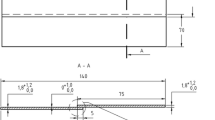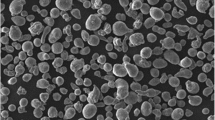Abstract
Laser welding has a large potential for the production of tailor welded blanks in the automotive industry, due to the low heat input and deep penetration. However, due to the small laser spot and melt pool, laser-based welding processes in general have a low tolerance for seam gaps. In this paper, five laser-based welding techniques are compared for their gap bridging capabilities: single-spot laser welding, twin-spot laser welding, single-spot laser welding with cold wire feeding, twin-spot laser welding with cold wire feeding and laser/GMA hybrid welding. Welding experiments were performed on 1.1- and 2.1-mm-thick AA5182 aluminium sheets. The resulting welds were evaluated using visual inspection, cross sectional analysis with optical microscopy, tensile tests and Erichsen Cupping tests. The results show that the use of a filler wire is indispensable to increase the gap tolerance. A proper alignment of this wire with the laser spot(s) is crucial. With the single spot laser welding with cold wire feeding, a gap up to 0.6 mm could be bridged as opposed to a maximum allowable gap width of 0.2 mm for single-spot laser welding without filler wire. For 2.1-mm-thick sheets, the laser/GMA hybrid welding process can bridge even gaps up to 1.0 mm. Most welds had a high tensile strength. However, during Erichsen Cupping tests, the deformation of the welds is significantly lower as compared to the base material.
Similar content being viewed by others
References
Davies RW, Oliver HE, Smith MT, Grant GJ (1999) Characterizing Al tailor-welded blanks for automotive applications. JOM 51:6–50
van Nieuwerburgh D, Smeyers A, van der Veldt T (2004) Market introduction of Al tailor welded blank technology. In: Proc. of EALA ’04
Duley WW (1999) Laser welding. Wiley, New York
Aalderink BJ, Aarts RGKM, Meijer J (2007) Increased gap bridging capabilities using twin spot and hybrid laser/GMA welding for AA5182. In: Proc. of LIM 07. AT-Verlag, Munich, pp 79–83
Aalderink BJ (2007) Sensing, monitoring and control of laser based welding of aluminium sheets. PhD thesis, Enschede, University of Twente
Hakvoort WBJ (2009) Iterative learning control for LTV systems with applications to an industrial robot. PhD thesis, Enschede, University of Twente
Hohenberger B, Chang CL, Schinzel C, Dausinger F, Hügel H (1999) Laser welding with Nd:YAG-Multi-Beam technique. In: Proc. of ICALEO ’99, pp D167–D176
Iwase T, Shibata K, Sakamoto H, Dausinger F, Hohenberger B, Müller M, Matsunawa A, Seto N (2000) Real time x-ray observations of dual beam welding of aluminium alloys. In: Proc. of ICALEO ’00, pp 26–34
Xie J (2001) Dual beam laser welding. Weld J 81(9):223-s–230-s
Schneegans J (1992) Untersuchungen zum laserstrahlschweissen mit zusatzdrahtfürung an un- und niedriglegierten Stälen. PhD thesis, Rheinisch-Westfälische Technische Hochschule Aachen
Fuest D (1995) Entwicklung von systemkomponenten zur automatisierung von CO2-laserstrahlprozessen mit zusatzdraht. PhD thesis, Rheinisch-Westfälische Technische Hochschule Aachen
Bagger C, Olsen FO (2005) Review of laser hybrid welding. J Laser Appl 17:1–14
Mahrle A, Beyer E (2006) Hybrid laser beam welding—classification, characteristics and applications. J Laser Appl 18:169–180
Cao X, Wallace W, Poon C, Immarigeon JP (2003) Research and progress in laser welding of wrought aluminum alloys. I. Laser welding processes. Mater Manuf Process 18(1):1–22
ISO (2001) ISO 13919-2: welding—electron and laser beam welded joints—guidance on quality levels for imperfections—part 2: aluminium and its weldable alloys
Armao F (2003) Invesigation of the smut generation during welding aluminium alloy with GMAW. Pract Weld Today 7:40–41
Jyogan S, Kogane K, Sasabe S, Hirano H, Ochiai T, Okita T (1998) How to recognize, minimize weld smut. In: Proc. of Inalco 98. Woodhead, Cambridge, pp 17–25
Aalderink BJ, de Lange DF, Aarts RGKM, Meijer J (2007) Keyhole shapes during laser welding of thin metal sheets. J Phys D Appl Phys 40:5388–5393
Huwer A (1993) Sensorsystem zur erfassung variabler fügespaltweiten beim laserstrahlschweissen im stumpfstoss. PhD thesis, Aachen, Rheinisch-Westfälische Technische Hochschule Aachen
Wen W, Morris JG (2004) The effect of cold rolling and annealing on the serrated yielding phenomenon of AA5182 aluminum alloy. Math Sci Eng A 373:204–216
ASTM International (1998) ASTM E 8M-98: standard test method for tension testing of metallic materials [Metric]
ASTM International (1984) ASTM E 643-84: standard test method for ball punch deformation of metallic sheet material
Author information
Authors and Affiliations
Corresponding author
Rights and permissions
About this article
Cite this article
Aalderink, B.J., Pathiraj, B. & Aarts, R.G.K.M. Seam gap bridging of laser based processes for the welding of aluminium sheets for industrial applications. Int J Adv Manuf Technol 48, 143–154 (2010). https://doi.org/10.1007/s00170-009-2270-x
Received:
Accepted:
Published:
Issue Date:
DOI: https://doi.org/10.1007/s00170-009-2270-x




